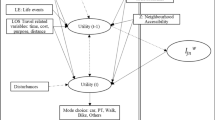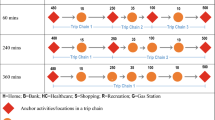Abstract
Trip chaining is a growing phenomenon in travel and activity behaviour. Individuals increasingly seek out opportunities to minimise the amount of travel required as part of activity fulfilment, given the competing demands on time budgets and their valuation of travel time savings. This search for ways of fulfilling (more) activities with less travel input has produced a number of responses, one of which is trip chaining. A particularly important policy implication of trip chaining is the potential barrier it creates in attracting car users to switch to public transport. This paper seeks to improve our understanding of trip chaining as a barrier to public transport use. A series of discrete choice models are estimated to identify the role that socio-economic and demographic characteristics of households have on the propensity to undertake trip chains of varying degrees of simplicity/complexity that involve use of the car or public transport with an embedded commuting or non-commuting primary purpose. Multinomial logit, nested logit and random parameter logit models are developed and contrasted to establish the gains in relaxing the strict conditions of the multinomial logit model.
Similar content being viewed by others
References
Algers S, Daly A, Kjellman P & Widlert S (1995) Stockholm model system (SIMS): application. In: Hensher DA et al. (eds) Modelling transport Systems, Volume 2, Proceedings of 7th World Conference on Transport Research (pp 345-361) Oxford: Pergamon Press.
Ben-Akiva M & Lerman S (1985) Discrete Choice Analysis. Cambridge, Mass: MIT Press.
Bhat C (1995) A heteroscedastic extreme value model of intercity travel model choice Transportation Research 29B(6): 471-483.
Bhat C (1997) Recent methodological advances relevant to activity and trave behavior analysis, Conference Pre-prints, IATBR'97. The 8th Meeting of the International Association of Travel Behaviour Research. Austin, Texas.
Bhat C (1999) Quasi-random Maximum Simulated Likelihood Estimation of the Mixed Multinomial Logit Model. Department of Civil Engineering, University of Texas at Austin, Texas.
Brog W & Schadler M (1998) Marketing in public transport in an investment, not a cost.Papers of the Australiasian Transport Research Forum 22, Part 2: 619-634.
Brownstone D & Train K (1999) Forecasting new product penetration with flexible substitution patterns. Journal of Econometrics 89(1-2): 109-129.
Garling T, Brannas K, Garvill J, Golledge RG, Gopal S, Holm E & Lindberg E (1989) Household Activity Scheduling (Paper presented at the fifth world conference on Transport Research, Yokohama, Japan, July 1989).
Golob TF (1998) A simultaneous model of activity participation and trip chain generation by households, paper presented at the IATBR'97 International Association of Travel Behavior Research Conference, Austin, Texas, 21-25 July.
Golob TF & McNally MG (1997) A model of activity participation and travel interactions between household heads. Transportation Research 31B(3).
Hensher DA & Johnson LW (1981) Applied Discrete Choice Modelling. London: Croom Helm.
Hensher DA (1998) The imbalance between car and public transport use in urban Australia: why does it exist? Transport Policy 5(4): 193-204.
Hensher DA (1999) The Valuation of Time Savings for Urban Car Drivers in New Zealand: 359 Evaluating Alternative Model Specifications. Institute of Transport Studies, The University of Sydney, September.
Henser DA & Greene WH (1999) Specification and Estimation of Nested Logit Models. Institute of Transport Studies, The University of Sydney, May.
Hensher DA, Louviere JJ & Swait J (1999) Combining sources of preference data. Journal of Econometrics 89: 197-221.
Kitamura R (1983) Sequential, history dependent approach to trip-chaining behaviour. Transportation Research Record 944.
Kitamura R (1988) An evaluation of activity-based travel analysis. Transportation 15: 9-34.
Lovelock CH, Lewin G, Day GS & Bateson JEG (1987) The Marketing of Public Transport. New York: Praeger.
McFadden DL (1981) Econometric models of probabilistic choice. In: Manski CF & McFadden DL (eds) Structural Analysis of Discrete Data (pp 198-271). Cambridge Massachusetts: MIT Press.
McFadden D & Train K (1996) Mixed MNL Models for Discrete Response. Department of Economics, University of California at Berkeley.
McFadden D & Train K (1997) Mixed MNL models for discrete responseApplied Econometrics forthcoming.
Morokoff W & Caflisch R (1995) Quasi-Monte Carlo integration. Journal of Computational Physics 122: 218-230.
NSW Government (1998) Action for Transport 2010 - An Integrated Transport Plan for Sydney.
Oster CV (1979) Second Role of the work trip - visiting non work destinations. Transportation Research Record 728: 79-81
Revelt D & Train K (1996) Incentives for Appliance Efficiency: Random Parameters Logit Models for Households; Choices. Department of Economics, University of California, Berkeley.
Shiftman Y (1998) Practical approach to model trip chaining. Transportaion Research Record 1645: 17-23.
Sloan J & Wozniakowski H (1998) When are quasi-Monte Carlo alogirthms efficient for high dimensional integrals? Journal of Complexity 14: 1-33.
Strathman JG, Dueker KJ & Davis JS (1994) Effects of household structure and selected characteristics on trip chaining. Transportation 21: 23-45.
Strathman JG & Dueker KJ (1995) Understanding trip chaining. Special Reports on Trip and Vehicle Attributes, 1990 NPTS Report Series, US Department of Transportation, February.
Train K (1997) Mixed logit models for recreation deman. In: Kling C & Herriges J (eds) Valuing the Environment Using Recreation Demand Models. New York: Elgar Press.
Train K (1999) Halton Sequences for Mixed Logits. Department of Economics, University of California at Berkeley, August 2.
Transport Data Centre (1996) Data and Models for Understanding and Monitoring Travel Behaviour (NSW Department of Transport, Transport Data Center Report 96/2).
Transport Data Centre (1996a) Public Transport Travel Patterns in the Greater Sydney Metropolitan area 1981 to 1991 (NSW Department of Transport, Transport Data Centre Report 96/3).
Author information
Authors and Affiliations
Rights and permissions
About this article
Cite this article
Hensher, D.A., Reyes, A.J. Trip chaining as a barrier to the propensity to use public transport. Transportation 27, 341–361 (2000). https://doi.org/10.1023/A:1005246916731
Issue Date:
DOI: https://doi.org/10.1023/A:1005246916731




